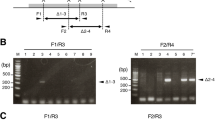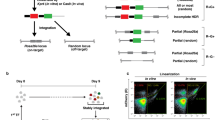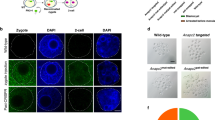Abstract
SPECIFIC genes can be inactivated or mutated in the mouse germ line1. The phenotypic consequences of the mutation can provide pivotal information on the function of the gene in development and maintenance of the mammalian organism. The procedure entails homologous recombination in embryonic stem cells, which, on fusion to recipient blastocysts, give rise to chimaeric mice that can transmit the mutant gene to their offspring. Inbreeding can then yield mice carrying the mutation in both alleles allowing the phenotypic analysis of recessive mutations. In addition to mice lacking a particular gene function, cell lines carrying null alleles of normally expressed genes can be instrumental in assessing the function of the gene. These cell lines can either be obtained from homozygous animals or, should the mutation be lethal early in embryonic development, be generated by consecutive inactivation of both alleles by homologous recombination in cultured cells. Here we illustrate the feasibility of this latter approach by the efficient consecutive inactivation of both alleles of the pim-1 proto-oncogene in embryonic stem cells.
This is a preview of subscription content, access via your institution
Access options
Subscribe to this journal
Receive 51 print issues and online access
$199.00 per year
only $3.90 per issue
Buy this article
- Purchase on Springer Link
- Instant access to full article PDF
Prices may be subject to local taxes which are calculated during checkout
Similar content being viewed by others
References
Capecchi, M. R. Science 244, 1288–1292 (1989).
Berns, A., Cuypers, H. T., Selten, G. & Domen, J. in Pim-1 activation in T-cell lymphomas in Viral Carcinogenesis, Alfred Benzon Symposium (eds Kjeldgaard, N. O., Forchhammer, J. 211–224 (Munksgaard, Copenhagen, 1987).
Amson, R. et al. Proc. natn. Acad. Sci. U.S.A. 86, 8857–8861 (1989).
Sorrentino, V., McKinney, M. D., Giorgi, M., Geremia, R. & Fleissner, E. Proc. natn. Acad. Sci. U.S.A. 85, 2191–2195 (1988).
Van Lohuizen, M. et al. Cell 56, 673–682 (1989).
Breuer, M. et al. Nature 340, 61–63 (1989).
Selten, G. et al. Cell 46, 603–611 (1986).
Adair, G. M. et al. Proc. natn. Acad. Sci. U.S.A. 86, 4574–4578 (1989).
Capecchi, M. Nature 344, 105 (1990).
Hooper, M., Hardy, K., Handyside, A., Hunter, S. & Monk, M. Nature 326, 292–295 (1987).
Adra, C. N., Boer, P. H. & McBurney, M. W. Gene 60, 65–74 (1987).
Kozak, M. J. molec. Biol. 196, 947–950 (1987).
Reiss, B., Sprengel, R. & Schaller, H. EMBO J. 3, 3317–3322 (1984).
Thomas, K. R. & Capecchi, M. R. Cell 51, 503–512 (1987).
Linney, E., Davis, B., Overhauser, J., Chao, E. & Fan, H. Nature 308, 470–472 (1984).
Gritz, L. & Davies, J. Gene 25, 179–188 (1983).
Kaster, K. R., Burgett, S. G., Rao, R. N. & Ingolia, T. D. Nucleic Acids Res. 11, 6895–6911 (1983).
Author information
Authors and Affiliations
Rights and permissions
About this article
Cite this article
te Riele, H., Maandag, E., Clarke, A. et al. Consecutive inactivation of both alleles of the pim-1 proto-oncogene by homologous recombination in embryonic stem cells. Nature 348, 649–651 (1990). https://doi.org/10.1038/348649a0
Received:
Accepted:
Issue Date:
DOI: https://doi.org/10.1038/348649a0
This article is cited by
-
One-step generation of conditional and reversible gene knockouts
Nature Methods (2017)
-
Developmental stage-specific effects of Pim-1 dysregulation on murine bone marrow B cell development
BMC Immunology (2016)
-
Alternative end-joining is suppressed by the canonical NHEJ component Xrcc4–ligase IV during chromosomal translocation formation
Nature Structural & Molecular Biology (2010)
-
Targeted conditional gene knockout in human embryonic stem cells
Cell Research (2010)
-
Efficient KRT14 Targeting and Functional Characterization of Transplanted Human Keratinocytes for the Treatment of Epidermolysis Bullosa Simplex
Molecular Therapy (2010)
Comments
By submitting a comment you agree to abide by our Terms and Community Guidelines. If you find something abusive or that does not comply with our terms or guidelines please flag it as inappropriate.



